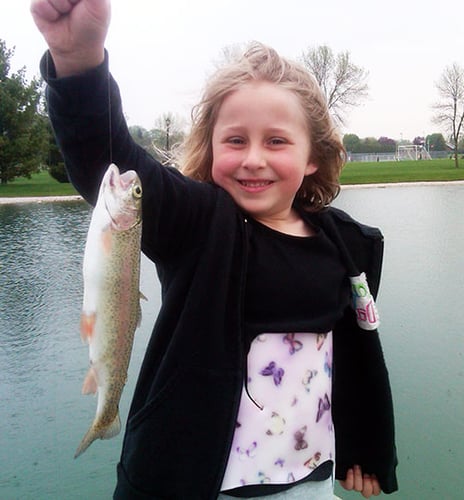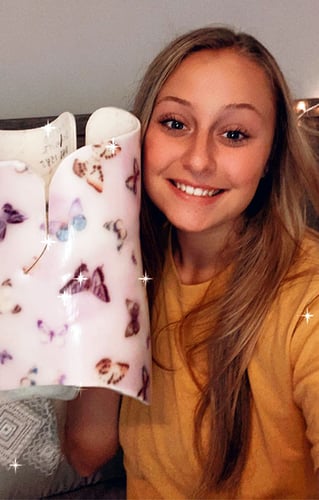
In 2010, when Emerson was only 4 years old, her pediatrician noticed an S-shaped curvature in Emerson’s spine and suspected it was scoliosis. While scoliosis can appear in children at any age, it is quite uncommon for a 4-year-old to be affected.
“I was very concerned that there was something more wrong than scoliosis because it’s something you typically don’t see until adolescence,” said Tracy, Emerson’s mom who is a long-time pediatric nurse in the Fox Valley area.
Tracy and her husband, Keith, chose to come to Children’s Wisconsin because they knew Emerson’s young age meant long-term treatment. In addition, Tracy knew that Emerson would need an X-ray of her spine to make a firm diagnosis, and the low-dose radiation that Children’s Wisconsin uses through the EOS scanner was a big selling point. The EOS scanner produces significantly less radiation compared to typical X-rays and is safer for children with progressive conditions who will need multiple scans throughout their life.
Emerson met with Allison Duey-Holtz, APNP, and Channing Tassone, MD, from the Comprehensive Spine Program at Children’s Wisconsin, who diagnosed Emerson with scoliosis and nothing more, much to Tracy’s relief.
Non-surgical treatment
 Due to the severity of Emerson’s spinal curve, Allison and Dr. Tassone recommended a Boston brace for her as soon as possible. A Boston brace is a plastic body jacket, also referred to as a Thoraco-Lumbo-Sacral Orthosis (TLSO) brace, which wraps under the arms and around the rib cage, lower back and hips to keep the spine in a straighter position.
Due to the severity of Emerson’s spinal curve, Allison and Dr. Tassone recommended a Boston brace for her as soon as possible. A Boston brace is a plastic body jacket, also referred to as a Thoraco-Lumbo-Sacral Orthosis (TLSO) brace, which wraps under the arms and around the rib cage, lower back and hips to keep the spine in a straighter position.
Typically, a Boston brace is worn 18-23 hours a day. Since Emerson was only 4 and had many more years to grow, the chance of her curve becoming worse was high. To avoid a surgical correction, Allison and Dr. Tassone wanted Emerson to wear the brace 23 hours a day.
“Asking our patients to wear a scoliosis brace, especially the full-time brace, is the hardest part of my job,” said Allison. “Brace wearing presents its own unique challenges at each stage of development. We are passionate about providing the physical and social/emotional support for our patients to help them successfully adapt to a brace.”
It was challenging for Emerson to wear the brace as much as possible, especially in the beginning because she was so young.
“Her 4K teacher was phenomenal. She explained to the kids that the brace was Emerson’s new shell,” said Tracy. “In the beginning we used a lot of different rewards to encourage Emerson. It was challenging times.”
Now 14 years old, Emerson compares her experience with the brace to that of riding a roller coaster.
“I remember not always liking it and not wanting to wear it all the time, but I knew I had to wear it to help my back,” said Emerson. “After a while though, it became habit.”
Tracy’s only concern about the Boston brace was that it would hold Emerson back from doing the things that little girls do.
“The brace was extremely difficult to move around in and Emerson was very, very active so she felt restrained,” said Tracy.
Allison encouraged Emerson to continue her activities because brace wearing can cause loss of muscle strength. Over the years, Emerson played softball, volleyball, swimming and basketball, removing the brace only for practices and games. Emerson appreciated that Allison understood her desire to play sports and stay active.
“We never want a scoliosis brace to keep our patients from being a kid and doing all of the activities that they love to do,” said Allison. “Emerson embodied that philosophy, figuring out how to balance brace wear with school and activities and never letting the brace keep her from living her life. While it wasn’t easy at times, in the end she has been an inspiration to many.”
Life-changing experience
 Over a period of 10 years, Emerson was fitted for and wore a total of five braces, but she never let the brace define her.
Over a period of 10 years, Emerson was fitted for and wore a total of five braces, but she never let the brace define her.
“Emerson never wanted to be known as the kid with a brace,” said Tracy. “We made alterations to the brace itself so that it was more comfortable to wear, and my mother-in-law and I made a lot of clothing alterations over the years so the brace was less obvious. Emerson went on to be a big softball player and still plays volleyball. It was challenging to see her go through this, but she didn’t let it stop her.”
Despite the difficulties, the Boston brace worked for Emerson. She stopped wearing it in August 2020 because she’s done growing and there’s little chance her curve will worsen. Not only did Emerson avoid a spinal surgery, but her degree of curve unexpectedly improved from when she was 4 to her last X-ray at age 14.
“We actually exceeded our treatment goal because our goal was just to stop her curve from worsening,” said Tracy.
Tracy credits the entire Children’s Wisconsin team for being a huge support system for the family over the years.
“We cannot say enough about Children’s Wisconsin, honestly. Our entire journey was unbelievable,” said Tracy. “The experience and reputation of Children’s Wisconsin and the Scoliosis Clinic was huge, and the entire team was there for us long-term.”
Tracy especially valued her experience working with Allison.
“Allison was our main point of contact and she was with us from the first appointment on day one until now. Knowing she was there for us was unreal,” said Tracy. “I was such a worried mom and Allison calmed my fears greatly. I give her so much credit.”
For Emerson, the impact of 10 years of brace wearing has given her more than just a healthy spine.
“The Boston brace has changed my life because it gave me an experience not everyone will know,” said Emerson. “I was always asked a lot of questions about it and am still asked a lot of questions. The experience has allowed me to help others.”
Helping others understand scoliosis is something Emerson may take to the next level in the future — she recently mentioned to her mom that she’d like to be an orthopedic surgeon.
Children's Wisconsin Resources

Written by
Jen Novotny
Writer
Related Stories
No related articles found.



